Technology Category
- Application Infrastructure & Middleware - Data Exchange & Integration
- Platform as a Service (PaaS) - Data Management Platforms
Applicable Industries
- Healthcare & Hospitals
- Paper & Pulp
Applicable Functions
- Product Research & Development
- Quality Assurance
Use Cases
- Personnel Tracking & Monitoring
- Time Sensitive Networking
Services
- System Integration
About The Customer
The Crofoot Clinic and Research Center, headed by Dr. Gordon E Crofoot, has been a pioneer in HIV/AIDS research since the 1980s. The center has participated in over 130 clinical trials for HIV, as well as Hepatitis B and C, and is currently involved in Phase III of the global Mosaico AIDS vaccine trial. The center's small, dedicated staff manages between 15 and 20 clinical trials at any given time. For many of the center's patients, participation in clinical studies may be their best or only chance to access treatments. The center is committed to making treatment and therapies available to its patients, particularly those from underserved communities.
The Challenge
The Crofoot Clinic and Research Center, a pioneer in HIV/AIDS research, was grappling with the challenge of outdated, paper-based processes for clinical research documentation. Despite the widespread adoption of digital healthcare technologies, the clinic's research documentation remained largely paper-based, making it difficult for investigators and support staff to manage and access necessary documents. The paper-based system also posed significant challenges for patients participating in clinical trials, who often had to take time off work to review and sign consent forms at the clinic. The complexity of managing patient consent forms, coupled with the logistical challenges of a sprawling metropolitan area like Houston, made it difficult for potential study candidates to consider participating in a clinical trial. The lack of integration between the clinic's data management systems and the various eConsent forms used by sponsors further complicated the situation, increasing work and compliance risks.
The Solution
The Crofoot Clinic adopted Veeva's digital consent technology, becoming the first clinical research center in the world to digitally consent a patient. This system connects sites and patients in one system, eliminating the need for paper-based consent forms and logs. It also allows patients to access their consent forms and other documentation remotely, giving them more time to review the documents and discuss them with family members. The digital system also improves connections between individual physicians in private practices and centers for clinical research, aiding in recruitment efforts. The adoption of this technology has saved the clinic significant time and money, allowing staff to focus more on patient care. The system also ensures that patients' consent is truly informed, as they can confirm potential study subjects without leaving their homes.
Operational Impact
Quantitative Benefit

Case Study missing?
Start adding your own!
Register with your work email and create a new case study profile for your business.
Related Case Studies.

Case Study
Hospital Inventory Management
The hospital supply chain team is responsible for ensuring that the right medical supplies are readily available to clinicians when and where needed, and to do so in the most efficient manner possible. However, many of the systems and processes in use at the cancer center for supply chain management were not best suited to support these goals. Barcoding technology, a commonly used method for inventory management of medical supplies, is labor intensive, time consuming, does not provide real-time visibility into inventory levels and can be prone to error. Consequently, the lack of accurate and real-time visibility into inventory levels across multiple supply rooms in multiple hospital facilities creates additional inefficiency in the system causing over-ordering, hoarding, and wasted supplies. Other sources of waste and cost were also identified as candidates for improvement. Existing systems and processes did not provide adequate security for high-cost inventory within the hospital, which was another driver of cost. A lack of visibility into expiration dates for supplies resulted in supplies being wasted due to past expiry dates. Storage of supplies was also a key consideration given the location of the cancer center’s facilities in a dense urban setting, where space is always at a premium. In order to address the challenges outlined above, the hospital sought a solution that would provide real-time inventory information with high levels of accuracy, reduce the level of manual effort required and enable data driven decision making to ensure that the right supplies were readily available to clinicians in the right location at the right time.

Case Study
Gas Pipeline Monitoring System for Hospitals
This system integrator focuses on providing centralized gas pipeline monitoring systems for hospitals. The service they provide makes it possible for hospitals to reduce both maintenance and labor costs. Since hospitals may not have an existing network suitable for this type of system, GPRS communication provides an easy and ready-to-use solution for remote, distributed monitoring systems System Requirements - GPRS communication - Seamless connection with SCADA software - Simple, front-end control capability - Expandable I/O channels - Combine AI, DI, and DO channels

Case Study
Driving Digital Transformations for Vitro Diagnostic Medical Devices
Diagnostic devices play a vital role in helping to improve healthcare delivery. In fact, an estimated 60 percent of the world’s medical decisions are made with support from in vitrodiagnostics (IVD) solutions, such as those provided by Roche Diagnostics, an industry leader. As the demand for medical diagnostic services grows rapidly in hospitals and clinics across China, so does the market for IVD solutions. In addition, the typically high cost of these diagnostic devices means that comprehensive post-sales services are needed. Wanteed to improve three portions of thr IVD:1. Remotely monitor and manage IVD devices as fixed assets.2. Optimizing device availability with predictive maintenance.3. Recommending the best IVD solution for a customer’s needs.

Case Study
Wireless Improves Efficiency in Compressed Air Systems
Hollingsworth and Vose wanted to improve the efficiency of their compressed air system, lower the electricity expense component of manufacturing cost in their commodity industry, and conserve energy leading to lowered greenhouse gas emissions. Compressed air systems degrade over time and become leaky and inefficient. Hollingsworth and Vose wanted to increase the frequency of system inspections without paying the high cost of manual labor.

Case Study
HaemoCloud Global Blood Management System
1) Deliver a connected digital product system to protect and increase the differentiated value of Haemonetics blood and plasma solutions. 2) Improve patient outcomes by increasing the efficiency of blood supply flows. 3) Navigate and satisfy a complex web of global regulatory compliance requirements. 4) Reduce costly and labor-intensive maintenance procedures.







